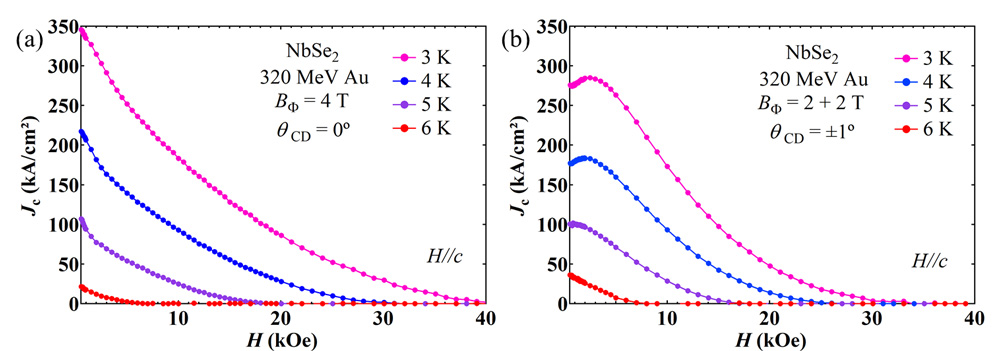PC1-1
Peak Effect Induced by Heavy-ion Irradiation in 2H-NbSe2 Single Crystals
Nov. 29 10:00-10:15
*Wenjie LI1, Sunseng PYON1, Ataru ICHINOSE2, Satoru OKAYASU3, Tsuyoshi TAMEGAI1
Department of Applied Physics, The University of Tokyo1
Grid Innovation Research Laboratory, Central Research Institute of Electric Power Industry2
Advanced Science Research Center, Japan Atomic Energy Agency3
As an effective method for improving the critical current density (Jc) of superconductors, heavy-ion irradiation is widely used [1]. Columnar defects (CDs) are introduced by heavy-ion irradiations, which are strong pinning centers to suppress vortex motion thus to enhance Jc. Other than Jc enhancement, an anomalous peak effect at ~1/3BΦ (BΦ is the dose equivalent matching field, and BΦ = 1 T corresponds to 5×1010 cm-2 CDs.) was observed in a twinned YBa2Cu3O7-δ single crystal when the magnetic field was applied parallel to CDs (θH = θCD; θH and θCD are angles from the c-axis to the applied field and CDs, respectively.) [2]. In their experiments [2], for distinguishing the effect of CDs introduced by heavy-ion irradiation from that of twin boundaries parallel to the c-axis on Jc, they intentionally introduced tilted CDs (θCD = 30º). If we can find a superconductor with no correlated defects, the peak effect can be observed without tilting CDs. The conventional low-temperature superconductor NbSe2 is such a good candidate. Contrary to our expectation, however, the peak effect was not observed when CDs were introduced parallel to the c-axis (θCD = 0º) and the field was applied along the c-axis (θH = 0º) as shown in Fig. 1(a). Although vortex structures for the two cases (θH = θCD = 30º and θH = θCD = 0º) are expected to be very similar intuitively, the results are very different. On the other hand, we have reported the presence of peak effect in NbSe2 with splayed CDs, where the splay angle is as small as ±5º [3]. In the present study, we introduced splayed CDs in NbSe2 with θCD = ±1º and observed a similar peak effect by applying magnetic field parallel to the c-axis (θH = 0º) as shown in Fig. 1(b). The fact that only ±1º splay of CDs induced behavior different from the case of θCD = 0º is unexpected. To find possible explanation for the difference between these two cases, studies on the θH dependence of Jc are necessary. In order to measure θH dependence of Jc efficiently and precisely, we modified the horizontal rotator for SQUID magnetometer (MPMS5-XL) and used small Hall probes set on the rotator to detect the local magnetic field from the sample and external field. We will present the θH dependence of Jc on samples with CDs parallel to the c-axis and with splayed CDs (θCD = ±1º), and discuss possible mechanism of the peak effect.
[1] T. Tamegai et al., Supercond. Sci. Technol. 25, 084008 (2012).
[2] L. Civale et al., Phys. Rev. Lett. 67, 648 (1991).
[3] W. Li et al., J. Phys. Conf. Ser. 2323, 012017 (2022).
Fig. 1. Magnetic field dependence of Jc for 2H - NbSe2 single crystals irradiated by 320 MeV Au (a) along the c-axis (BΦ = 4 T, θCD = 0º) and (b) from two directions symmetrically (Total BΦ = 4 T, θCD = ±1º ).
Keywords: NbSe2, heavy-ion irradiation, peak effect
